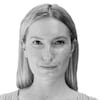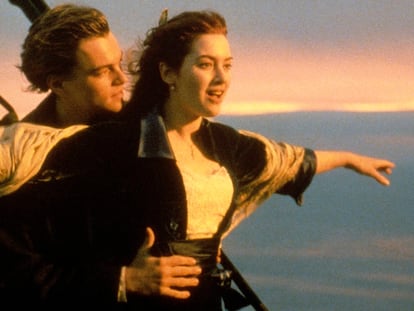The night the crew of ‘Titanic’ was drugged with angel dust in their soup
In 1996, director James Cameron and more than 80 of the film’s crew ended up doing a conga line in a Canadian hospital after dining on a drug-laced chowder. The culprits were never found, but now the release of police reports from the time may solve one of cinema’s mysteries

James Cameron said that it was mussel chowder. Bill Paxton thought it was clam chowder. Whatever it was, on the night of August 8, 1996, the Titanic crew was in Halifax, Nova Scotia, Canada, for their last day of filming in the city. That day, they were to finish the scenes set in the present (“It’s been 84 years...,” etc.) and immediately go to Baja California, Mexico, where a monumental replica of the doomed ship awaited them in a huge open-air studio. They filmed at dusk, and at around midnight, the crew took a break for dinner. Among other options, the local caterer served seafood chowder. “The chowder was unbelievable. People were going back for second bowls,” artist Marilyn McAvoy, who was in charge of recreating the recognizable artwork featured in the film, told Vice in 2017. “And I think that was part of the problem: people ate a lot more than usual because it was so delicious.” What happened next will surprise you.
At the time, it was reported that around 60 people were drugged; that figure has since increased to 80. In an interview in Vanity Fair, the director of the hit film revealed that he noticed the effects almost immediately, because he had to leave the set to vomit. At first he thought it was seafood poisoning. When he went back, he was “standing at the monitors, near the camera, and the room is empty. It was like the Twilight Zone,” he said. Actor Bill Paxton, who played treasure hunter Brock Lovett, with whom the film opens, told Entertainment Weekly magazine that he began to notice the effects 15 minutes after eating the soup: “The crew was all milling about. Some people were laughing, some people were crying, some people were throwing up.” Believing, like Cameron, that he might be suffering from food poisoning, Paxton jumped into a van with others from the Titanic set and went to Dartmouth General Hospital. “One minute I felt okay, the next minute I felt so goddamn anxious I wanted to breathe in a paper bag. Cameron was feeling the same way.”
Gradually, the hospital waiting room filled up with other crew members. Leonardo DiCaprio and Kate Winslet were spared because they were not called to the set at that time. “In masse, we went through these hospital doors at 1 a.m. in the morning. They did not know what to do with us. It became pretty chaotic. I didn’t have any experience with drugs,” said painter Marilyn McAvoy. “But [others] were saying it was like the beginning of an acid trip.” James Cameron said that at one point he was stabbed by another crew member with a pen: “I’m sitting there bleeding and laughing,” he recalled. Several of those present stated at various times that a festive conga line formed in the hospital. “Eventually we all got put in these cubicles with the curtains around us, but no one wanted to stay in their cubicles,” the painter explained. “Everyone was out in the aisles and jumping into other people’s cubicles. People had a lot of energy. Some were in wheelchairs, flying down the hallways. I mean, everyone was high!”
“These people were stoned,” said Dr. Rob Roy, who treated several of the victims that night. “They had no idea what was going on.” At one point, Dartmouth General Hospital called the Halifax police. It was out of control. And it looked strange. A tox screen was conducted at the medical center, and on August 28, Halifax police issued a statement confirming what many already suspected: they had indeed been drugged. Someone had laced the seafood chowder with phencyclidine, popularly known as PCP or angel dust,” a white, crystalline powder that dissolves easily in water or alcohol” that “was used in the 1950s as an intravenous anesthetic, but ceased to be used due to the side effects it produced in patients.” Angel dust is a member of the family of dissociative anesthetics, which includes ketamine. PCP’s effects range from euphoria to panic. At high doses, its effects are said to resemble symptoms associated with schizophrenia, including delusions and paranoia. A good trip.

The evidence was irrefutable, but one question remained: who drugged the seafood chowder? To this day, nearly three decades later, that is still a mystery: the Halifax police department investigated the event for more than two years, during which time it executed a search warrant and obtained a list of everyone who had worked on the set. But the case was closed for lack of evidence in 1999. Now, it may be close to resolution. As reported by several media outlets just a few days ago, a new ruling by Nova Scotia’s information and privacy commissioner has ordered Halifax police to release more details of the 10-page incident report they filed that night, as well as remove the redactions from some of the witness testimony. If the police meet the deadline, the records should be released in mid-May, and they could provide new details about an incident that was never resolved.
From the beginning, there were certain theories about it. “We have a pretty strong suspicion who it was, although it was never proven,” James Cameron himself recounted in an interview on the Q With Tom Power podcast. “We believe the story is that it was somebody who had a beef with the caterers because the first thing we did was fire the caterers. And, you know, sure enough, we had some leads on that.” In 1996, a few articles were published that pointed to the same theory: one of the two companies that catered the production had drugged the soup. To quell these rumors, the catering manager flatly denied that any of his workers could have done such a thing and insisted that “it was the Hollywood crowd bringing in the psychedelic shit. I don’t think it was purposefully done to hurt somebody. It was done like a party thing that got carried away.” On that same podcast, the filmmaker also addressed another theory, one that didn’t exactly make him look good: " Of course, the operating theory was that I was such a psycho maniac that [the perpetrator was] trying to get back at me, but I reject that theory out of hand for obvious reasons.” 28 years after that night, it’s hard to believe that the mystery will ever be solved. It doesn’t really matter. The night of Titanic’s spiked chowder has already become part of the history of modern cinema.
Sign up for our weekly newsletter to get more English-language news coverage from EL PAÍS USA Edition
Tu suscripción se está usando en otro dispositivo
¿Quieres añadir otro usuario a tu suscripción?
Si continúas leyendo en este dispositivo, no se podrá leer en el otro.
FlechaTu suscripción se está usando en otro dispositivo y solo puedes acceder a EL PAÍS desde un dispositivo a la vez.
Si quieres compartir tu cuenta, cambia tu suscripción a la modalidad Premium, así podrás añadir otro usuario. Cada uno accederá con su propia cuenta de email, lo que os permitirá personalizar vuestra experiencia en EL PAÍS.
¿Tienes una suscripción de empresa? Accede aquí para contratar más cuentas.
En el caso de no saber quién está usando tu cuenta, te recomendamos cambiar tu contraseña aquí.
Si decides continuar compartiendo tu cuenta, este mensaje se mostrará en tu dispositivo y en el de la otra persona que está usando tu cuenta de forma indefinida, afectando a tu experiencia de lectura. Puedes consultar aquí los términos y condiciones de la suscripción digital.
More information
Archived In
Últimas noticias
Most viewed
- Sinaloa Cartel war is taking its toll on Los Chapitos
- Oona Chaplin: ‘I told James Cameron that I was living in a treehouse and starting a permaculture project with a friend’
- Reinhard Genzel, Nobel laureate in physics: ‘One-minute videos will never give you the truth’
- Why the price of coffee has skyrocketed: from Brazilian plantations to specialty coffee houses
- Silver prices are going crazy: This is what’s fueling the rally











































